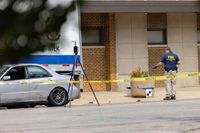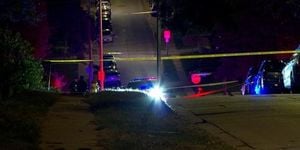Federal immigration enforcement has intensified across the United States in 2025, reaching a boiling point in Chicago after a fatal shooting involving U.S. Immigration and Customs Enforcement (ICE) agents and a Mexican immigrant. The incident, which unfolded in Franklin Park, a majority Hispanic suburb roughly 18 miles west of Chicago, has sparked a wave of public outcry, renewed scrutiny of ICE operations, and demands for transparency from advocates and officials alike.
On a September morning in Franklin Park, Silverio Villegas González, a 38-year-old cook and father originally from Michoacan, Mexico, was fatally shot by a federal immigration agent during a vehicle pursuit. According to reporting from the Associated Press and the Chicago Sun-Times, Villegas González had just dropped off one of his children at day care before the encounter that would end his life. The suburb, home to about 18,000 residents, was shaken as the event placed local schools on lockdown and prompted community protests.
Body camera footage released by the Franklin Park Police Department on September 23, 2025, cast new light on the circumstances of the shooting. The video, obtained through a Freedom of Information Act request and reviewed by AP, shows ICE agents explaining the moments leading up to the fatal gunfire. One agent can be heard stating, "He tried to run us over," while another, who sustained injuries during the incident, downplayed their severity, saying he was "dragged a little bit" and describing his wounds as "nothing major." The injured agent, visible in the footage with ripped jeans and blood on his hands, further specified, "a left knee injury and some lacerations to his hands."
This account stands in stark contrast to previous statements by the Department of Homeland Security (DHS) and Trump administration officials, who had characterized the officer's injuries as "multiple" and "serious." DHS Secretary Kristi Noem, who visited Chicago for an immigration operation the week prior, posted on X, "His life was put at risk and he sustained serious injuries." The discrepancy between these descriptions and the body camera footage has fueled calls for a thorough investigation.
U.S. Representative Jesus "Chuy" Garcia, a Chicago Democrat, voiced the community's frustration and demand for clarity. "We want answers to questions that we have raised," Garcia said following the video's release. "The family is entitled to it. The community wants to know what is going on, and the public deserves answers as well." The Consulate General of Mexico in Chicago echoed these sentiments, pledging to "closely monitor" the investigation into Villegas González's death.
According to DHS, Villegas González had a history of reckless driving and was living in the United States without legal permission. Federal officials stated that after being pulled over, Villegas González allegedly drove his car at the officers, dragging one of them a significant distance, which led the agent to open fire out of fear for his life. However, the lack of body cameras on the federal agents at the time has complicated efforts to reconstruct the exact sequence of events. The only available footage comes from local police who arrived after the shooting.
The aftermath of the shooting has reverberated beyond Franklin Park, intensifying debate over ICE’s expanding role and aggressive tactics. In 2025 alone, ICE has arrested more than 550 people in the Chicago area as part of a broader federal immigration crackdown, according to AP. The agency’s recent operations have drawn comparisons to similar crackdowns in Los Angeles earlier in the summer, where at least two individuals died while attempting to evade ICE—one falling from a greenhouse roof during a raid, another struck by an SUV while fleeing agents outside a Home Depot.
These incidents are part of a nationwide escalation in immigration enforcement. The Center for Agricultural Law and Taxation at Iowa State University, represented by counsel Kristiana Coutu, highlighted the surge in ICE worksite actions during a September 12, 2025, webinar. Coutu, a fourth-generation dairy farmer and former agricultural lawyer, explained that ICE, which operates under the Department of Homeland Security, has dramatically increased its presence at workplaces—especially farms—since the early days of the Trump administration. In the first 100 days alone, ICE agents arrested approximately 1,270 undocumented immigrants at worksites and proposed nearly $1 million in fines against employers.
Congress has responded to these enforcement priorities by allocating $75 billion to ICE over four years, with $28.7 billion available in 2025—nearly triple the agency’s 2024 budget, as reported by Forum Communications. This financial windfall has empowered ICE to serve more than 5,200 notices of I-9 inspection to businesses nationwide between January and July 2025, a fact that underscores the scale of the current crackdown.
At the heart of these enforcement efforts lies the Form I-9, a document employers must complete to verify that employees are authorized to work in the U.S. Coutu emphasized the importance of proper I-9 compliance, warning that technical errors or discrimination in reviewing documents can expose employers to civil fines or even criminal prosecution. Employers served with an ICE notice have at least three business days to produce I-9 documentation, and if a Notice of Technical or Procedural Failures is issued, they have ten business days to correct errors. In May 2025, ICE agents arrested 200 workers while serving audit notices to 187 businesses in Washington, D.C.—a vivid example of how audits can quickly escalate to arrests.
For many in Franklin Park and beyond, the death of Silverio Villegas González is a tragic symbol of the human cost of intensified immigration enforcement. Community members gathered at vigils to remember Villegas González as a devoted father and kind neighbor. The director of the day care where he dropped off his child described him as a good father. His story, and the conflicting narratives about the shooting, have become a flashpoint in the larger debate over federal immigration policy, the transparency of law enforcement, and the rights of immigrants.
As investigations continue and calls for accountability grow louder, the events in Franklin Park serve as a stark reminder of the profound consequences that federal policy decisions can have on individual lives and local communities. The search for answers—and for justice—remains ongoing.





